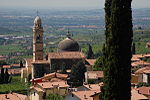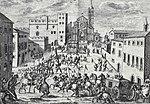Villa Mosconi Bertani

The Villa Mosconi Bertani (also known as Villa Novare) is a Neoclassical winery and manor in the Veneto region of Italy famous for its heritage in the production of Amarone della Valpolicella wine. It is located in the municipality of Negrar di Valpolicella, Località Novare, in the province of Verona. It is the only Veronese estate since the beginning of the 18th century specifically constructed for the purpose of wine production. It consists of a residence, large cellar and orchard (22 hectares (54 acres)). Villa Mosconi Bertani is also known to have been an important centre of Romanticism, through Italian poet and writer Ippolito Pindemonte, and also the cradle of Amarone wine. The complex is listed and protected as a historical landmark by the Ministry of Cultural Heritage and Activities. The villa, park and winery are open to the public for guided tours, cultural events and private parties. The villa now is the main winery for Tenuta Santa Maria, owned by the Bertani family.
Excerpt from the Wikipedia article Villa Mosconi Bertani (License: CC BY-SA 3.0, Authors, Images).Villa Mosconi Bertani
Giro di villa Novare,
Geographical coordinates (GPS) Address Nearby Places Show on map
Geographical coordinates (GPS)
| Latitude | Longitude |
|---|---|
| N 45.503558333333 ° | E 10.946444444444 ° |
Address
Giro di villa Novare
37024
Veneto, Italy
Open on Google Maps










